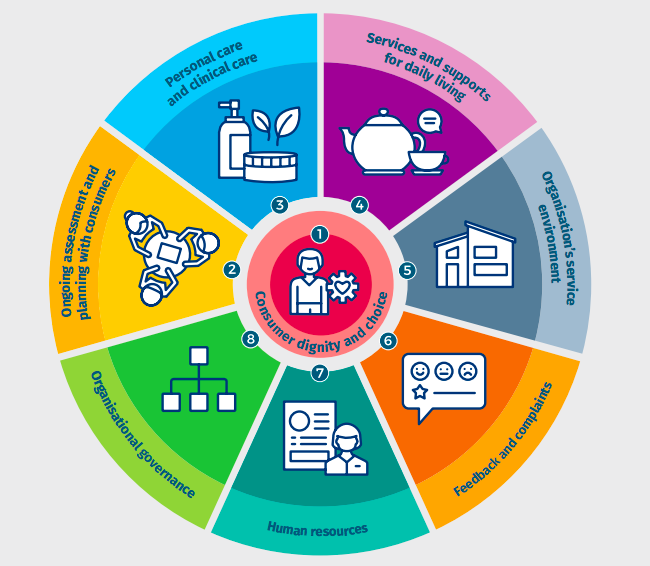If they’ve never been through a quality review, or they’ve been involved in a review in the past that didn’t go to well, your staff may be anxious about any upcoming reviews – especially if they think they are going to be ‘tested’ on their knowledge or they are concerned that they might say something ‘wrong’. Some of the services we’ve worked with that have staff from a non-English speaking background have noted that their staff are particularly concerned.

Equally, management staff are worried that staff will ‘clam up’ and not be able to articulate adequately to the assessment personnel. One organisation told a story about one of their staff members who was asked by a reviewer if they could describe what quality improvements the organisation had made. Although the staff member had sat through training on the Continuous Quality Improvement (CQI) cycle the previous week, they were unable to describe how the organisation demonstrated this concept. Likewise, when asked about what processes were in place in the event of an emergency, they merely shrugged, despite having been involved in evacuation training.
So how can you prepare your staff?
In the above situation, we helped the organisation identify examples of continuous improvement. We then ran a workshop with staff and, as a group, discussed both the concept of the CQI and used the examples to help staff visualise what it meant.
We also identified a daily training/spot check activity that helped drill staff in particular practices related to safety activities. I’m happy to say that the organisation passed with flying colours second time around with staff able to confidently respond to questions presented to them.
So, a great result! But recently, the same organisation contacted us to request some help preparing for their next quality review. They’re not sure they are ready against the new Standards. How should they be preparing their staff this time?
Firstly, I think it’s important to note that much of the preparation you have done in the past is still relevant. You still need to ensure that staff understand concepts like CQI and safety requirements. But what we also need to be doing is ensuring that our staff and services are always ready for a review.
We need to be proactively looking for ways to embed the knowledge of the Standards into our everyday practices, and often we do – but our staff don’t necessarily understand how they are meeting the Standards. They’re just ‘doing their job’.
This is where capturing examples of what happens in everyday care delivery as case studies and helping staff recognise how they map to the Standards comes in handy.
Let’s look at how this might work.
The new Aged Care Standards are very much focussed on the consumer experience.
Therefore, it is important for staff to recognise what good service looks like to the clients they support. It is often important to get the language right.
Let’s say a staff member has brought up a concern about the deterioration they noticed in Betty, one of their clients. Betty originally had a beautiful garden which was her pride and joy. But this year she hadn’t made an effort to plant out the usual annuals that adorned the garden beds leading up to her front door, and instead the beds were full of weeds.
The support worker also noticed that Betty no longer sat outside on her front verandah and that she seemed less animated and active in recent times. When asked why, Betty had told the support worker that she felt upset when she looked at the garden beds, but her arthritis was preventing her from getting down to do the weeding and planting out.
When this was reported to the Care Manager, they visited Betty and over a cup of tea they discussed options to support her, coming up with a solution that included a referral to the physiotherapist to identify ways to manage the arthritis and raising the front garden beds to make them more accessible.
Betty was found in her front garden busily planting out her raised garden beds when the Care Manager returned four weeks later. They sat out on her front verandah and enjoyed a cup of tea while Betty animatedly discussed how she had joined the local aqua-aerobics group in town and was attending twice a week, as well as going to a reformer Pilates class every Wednesday, noting that she had significantly less pain in her knees.
If this story was written up and discussed in the weekly staff meeting, you could also match the story to the Standards.
- We are recognising what Betty likes to do, what gives her joy – Standard One
- We planned a solution with her – Standard Two
- We helped with her activities of daily life and helped maintain independence – Standard Four
- Our staff member was capable of identifying a problem and caring enough to pass this on to the right person in the organisation – Standard Seven
Using resources such as the Aged Care Quality and Safety Commission’s ‘Standards wheel’ when discussing this story and the Standards that it meets is a great way of raising your staff’s awareness of the Standards and their contribution.

Try to weave the Standards into other aspects of your activities with staff.
Perhaps by borrowing from the colours of the Standards wheel or using one of the Standards posters to emphasise the Standard.
For example, when conducting your safety Toolbox Talk on hand washing at staff meetings highlight how this training meets:
- Standard Three – providing safe personal care
- Standard Four – providing safe meals to the client
- Of course, it’s also training and ensures your workforce is skilled and competent, therefore you are also covering Standard Seven.
What about discussing the outcome of client surveys with staff? If you start out by highlighting Standard Six (feedback), your staff are more likely to remember this when asked about how you gain feedback.
If you discuss a client complaint in the staff meeting and how it was resolved, you are helping staff to understand how these are dealt with. Completing the complaints register as part of the staff meeting or referring to it during the meeting also raises your staff’s awareness.
Perhaps you could include an orange coloured title box (the colour on the Commission’s wheel) to your complaints and / or feedback forms, just to emphasise this Standard.
When you conduct your internal audits, perhaps when checking that your building is safe and compliant, you can talk with staff about how these help your organisation to meet Standard Five and Standard Eight.
Make this fun! People learn better when they are enjoying themselves. Use the ‘chatterbox’ resource on the Commission’s website, print it out and have some fun with staff. Get staff to randomly choose the topic of discussion for that week’s staff meeting. Have them think on their feet, responding to whatever Standard is chosen.
And of course, all these ‘staff meetings’ should be documented as they are helping to demonstrate good governance and ensuring that the service is well run.
So, I hope that helps give you a heads up on proactively getting your staff prepared for not only your next quality review, but also helping them to understand the new Standards better.
- What’s the deal with Care Coordination? - May 21, 2024
- When Cancer Gets Up Close and Personal… - May 14, 2024
- Aged Care Packages – what’s in the box? - February 16, 2024



